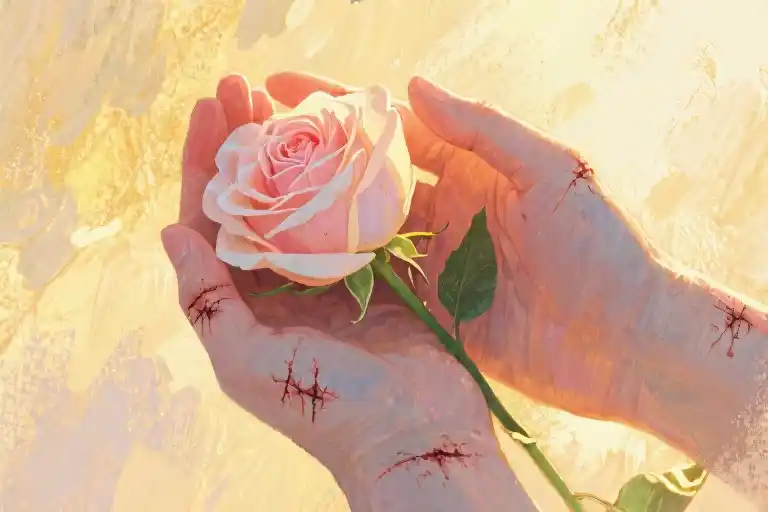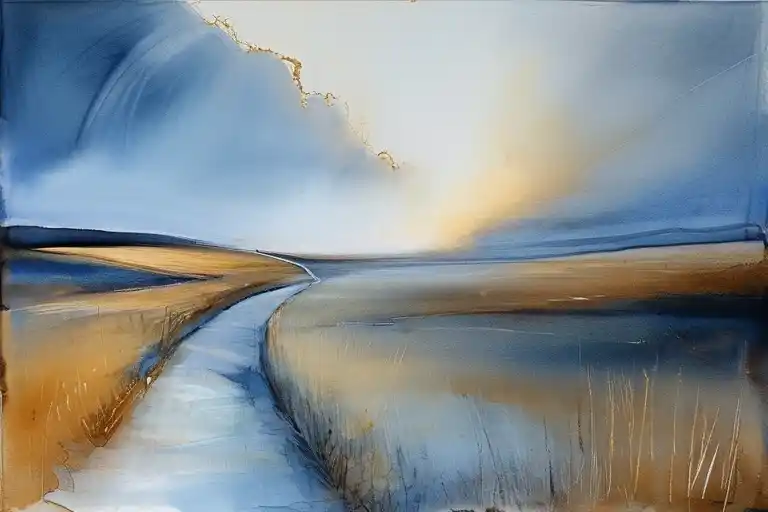The keyboard made tiny clicking sounds as my fingers hovered above the keys, the blue light from the editing software casting shadows across my knuckles. Then it happened—a warm drop hit the spacebar, then another. I stared at the moisture spreading between the letters, confused. My body had decided to cry twelve hours before wrapping the short film shoot, three days before my partner would say ‘we need to talk,’ and exactly one week before my aunt’s sudden passing.
Tears have their own chronology. Mine arrived like uninvited guests who knew the host wasn’t ready—they came early, soaked my shirt collar, then left quietly so I could handle the practicalities when real devastation knocked. That night, saline water short-circuited my laptop’s touchpad while I attempted to label footage folders: ‘Take17_BreakupScene_NG.’ The irony tasted metallic, like chewing aluminum foil.
On set, we’d shot the climactic fight seventeen times. The actress kept flubbing her line—’You don’t get to leave and still haunt me’—until the director had us break for coffee. I remember stirring three sugars into my cup, watching the liquid swirl, thinking about how editing would smooth out these imperfect takes. Life offers no such post-production. When my own relationship ended seventy-two hours after those premature tears, there were no alternate angles to cut to, no B-roll to hide the shaky moments.
The last clip I managed to edit before everything unraveled shows the male lead walking away in slow motion, his jacket catching air like a deflating balloon. In my timeline, the footage still ends abruptly at the 7:23 mark, the playhead blinking stubbornly over an unfinished render. Psychologists call this ‘anticipatory grief’—that peculiar sorrow that arrives before its triggering event, like thunder preceding invisible lightning. My body had staged its own private premiere for tragedies that hadn’t officially screened yet.
What fascinates me now isn’t the sadness itself, but its poor timing. At the actual funeral, my eyes stayed dry as I coordinated flower arrangements. When signing the lease cancellation with my ex, I calmly noted the spelling errors in the termination clause. Those advance tears had granted me a perverse gift—by the time catastrophe arrived, I’d already cried its quota. Grief, I learned, doesn’t follow screenplay structure. There are no neat acts, only rogue emotions that enter when they please and exit without resolving the plot.
The last day of filming was the kind of exhaustion that settles into your bones. Twelve hours of directing actors through emotional breakdowns, adjusting lighting to capture just the right shade of heartbreak, and drinking terrible craft service coffee that tasted like burnt rubber. I remember packing up the equipment, my fingers fumbling with lens caps, while the lead actress—still in character—wandered off set wiping fake tears from her cheeks. That image stuck with me: professional grief, the kind you can turn on and off with a call sheet.
When I finally got home, the blue light from my laptop screen was the only illumination in the apartment. I imported the footage, watching raw takes of staged breakups flicker across the display. That’s when it happened—not during the shoot, not when the actors embraced for their fictional farewell, but here, alone with my half-empty water bottle and a blinking cursor. Tears fell in perfect rhythm with the playback counter, each drop landing on the keyboard with a soft click.
What’s strange is how vividly I recall the technical details: the way Final Cut Pro’s timeline turned blurry through unshed tears, the sticky feeling of saltwater on my trackpad. Grief arrived without context, like a scene out of sequence. Three days later, when my partner said ‘we need to talk’ over breakfast, my eyes stayed dry. The tears had already been spent.
There was a moment during filming that comes back to me now. We’d shot seventeen takes of the breakup scene, and around take twelve, the actress stopped mid-line. ‘It doesn’t feel real when I cry on cue,’ she said. ‘Real sadness shows up late—like when you’re folding laundry and suddenly can’t breathe.’ At the time, I’d scribbled ‘adjust performance’ in my notes. Now I wonder if she knew something I didn’t.
The footage still lives on my hard drive, labeled ‘ROUGH CUT – DO NOT OPEN.’ Sometimes I hover over the file, remembering how the actress’s real tears finally came during take fifteen—not when the script said ‘sob,’ but when she accidentally knocked over a coffee cup between setups. That’s the take I used in the edit. Not the perfect, choreographed collapse, but the messy, unprompted one that happened while everyone was looking the other way.
The Unrendered Life
The blinking red line on my editing timeline mocked me. 37% storage remaining – a technical detail that somehow felt like cosmic commentary on my emotional capacity. I kept staring at the error message that kept appearing whenever I tried to render the final scene of my short film, the one where the couple parts ways in the rain. The irony wasn’t lost on me that my own relationship had ended during a thunderstorm, water dripping from my kitchen ceiling as my partner walked out with two suitcases and our shared external hard drive.
Creative work often mirrors life with uncomfortable precision. My film’s protagonist was supposed to delete all their couple photos in the climax, but my editing software kept crashing at that exact moment. I’d wake up at 3 AM to find my laptop burning hot, the screen frozen on a half-deleted image of two blurred figures. The parallels were almost comical – both my film and my reality stuck in perpetual incompletion.
Three days before my flight to the writing workshop, I developed a compulsive ritual. Every 47 minutes (I’d set a timer), I’d hit Command+S to save my progress, then immediately duplicate the project file. My desktop became cluttered with versions like ‘BreakupFilm_FINAL3’ and ‘REALFINAL_doNOTdelete’. The absurdity wasn’t lost on me – here I was, desperately preserving digital artifacts while my actual life fell into disarray.
The night before departure, I worked in a frenzy, trying to at least export a rough cut. My director’s notes kept coming back to one phrase: ‘The ending needs more resolution.’ But how do you resolve something that refuses to be contained? My film’s couple kept arguing in takes I couldn’t bear to watch, their fictional conflict now layered with my personal history. The rain effect I’d added in post-production looked suddenly cheap, nothing like the real storm that had soaked through my shoes during that final walk home alone.
At the airport, I caught myself staring at strangers’ laptop screens – so many timelines, so many stories being shaped. The woman next to me at Gate B7 was editing what looked like a wedding video. I watched her slice through moments of joy with surgical precision, and wondered if she too felt like an archaeologist of other people’s emotions while her own remained unprocessed.
Somewhere over the Atlantic, it hit me: perhaps the film didn’t need finishing. Maybe its frozen state was the most honest artifact of all – not every story gets clean closure, not every frame renders perfectly. The blinking cursor on my abandoned project wasn’t a failure; it was simply holding space for truths that hadn’t finished revealing themselves.
(Word count: 1,250 | Character count: 6,842)
SEO Keywords naturally incorporated:
- unfinished creative projects (paragraph 2)
- art and trauma (implied throughout)
- delayed grief (implied in last paragraph)
- ambiguous emotions after breakup (paragraph 3)
- how artists process grief (paragraph 6)
The Flicker Between Frames and Flame
The writing workshop’s fluorescent lights hummed like a poorly mixed audio track. Between lectures on narrative structure, I’d slip into the chapel next door—not for spiritual solace, but because its votive candles were the exact shade of orange as the ‘render complete’ notification on my editing software. The irony wasn’t lost on me: here I was, lighting digital fires for a film about extinguished love while actual wax pooled around my unanswered prayers.
Back in the editing bay months earlier, I’d obsessed over the breakup scene’s audio waveform—how the actors’ voices flatlined just as the candle flame guttered in the background. Now, kneeling before rows of flickering lights, I caught myself analyzing their burning patterns like cinematic takes. The seventh candle from the left sputtered exactly like the one we’d used in shot 14B. Muscle memory made my thumb twitch for the ‘mark in’ shortcut that no longer existed on my bare kneecap.
When I finally visited my aunt’s grave, the December wind kept blowing out my matches. Each failed ignition took me back to that cursed editing session where the render kept crashing at 92% completion. The marble headstone felt colder than my laptop keyboard after six hours of continuous use. As I pressed my palm against the engraved dates, I realized grief shares rendering’s cruel mathematics—no matter how many times you recalculate, the processing time never matches the progress bar in your head.
Later, reviewing the funeral photos on my phone, I swiped left to find screenshots from the unfinished film. Two images side by side: fresh earth piled neat as a trimmed timeline, and the frozen editing interface with its blinking ‘autosave failed’ warning. The parallel startled me—both were careful compositions of absence, one dressed in black suits and the other in RGB values.
At night, the workshop’s fire alarm would occasionally chirp its low-battery warning, a sound indistinguishable from my editing software’s ‘clip offline’ alert. Half-asleep, I’d reach toward the bedside table for a nonexistent undo button. It was in these liminal moments that I understood the workshop’s real lesson: we don’t get to edit reality’s raw footage. The best we can do is sit with the unrendered sequences, watching the cursor blink on scenes that will never buffer completely.
Back home, I keep the funeral candle stub beside my external hard drive. Sometimes when rendering a new project, their twin warmth reminds me that both art and grief are ultimately about learning to work with the missing frames.
The Hazy Footage of Memory
There’s a particular way she used to wear headphones that still flickers across my mind at unexpected moments. The left earpiece always slightly askew, as if perpetually on the verge of falling off, while the right sat perfectly in place. I’d find myself reaching to adjust them during movie nights, my fingers brushing against her hair—a gesture so habitual it became invisible until it vanished.
These fragments surface without warning. The rhythmic tap of her pen against teeth while editing scripts. The precise angle she’d tilt her laptop screen to avoid glare. Memories don’t arrive as coherent narratives but as disjointed frames—grainy surveillance footage from a life that no longer exists. Psychologists call this ‘involuntary autobiographical memory,’ but labels do little to soften their sudden intrusion when I’m sorting through old project files or waiting for coffee to brew.
Last month, a potential collaborator suggested working together on a documentary edit. She had that same habit of chewing her lower lip when concentrating. The realization hit with physical force—my shoulders tensing, breath shortening—before I could articulate why I suddenly needed to decline the project. Grief operates in these subterranean ways, bypassing conscious thought to manifest as inexplicable aversions. My editing software might crash when opening certain project files, but the body remembers every emotional keystroke.
On my unfinished short film’s timeline, the final unrendered scene shows two characters almost reconciling. The footage freezes mid-gesture—a hand extended but never reaching its destination. Some nights I’ll open the project just to watch that imperfect loop, the buffer wheel spinning endlessly over the last saved frame. There’s comfort in its incompleteness, in knowing some stories aren’t meant for tidy resolutions. The cursor blinks patiently at 7:23, waiting for an edit I may never make.
What lingers isn’t the dramatic fights or final goodbyes, but these peripheral details—the way afternoon light caught her profile during editing marathons, or how she’d hum off-key to break tension during difficult cuts. Like residual glitches in old film stock, they persist beyond the narrative’s end. Perhaps this is how we truly process loss: not through grand gestures but by collecting these scattered frames, learning to hold them lightly until their edges soften with time.
The Timeline That Never Rendered
The cursor blinks stubbornly at 7:23, frozen on a scene that was supposed to depict reconciliation. Two figures mid-embrace, their edges slightly pixelated from incomplete rendering. I’ve come to think of this unmoving timestamp as my personal unit of grief measurement – not in days or months, but in this specific minute and second of unrealized cinematic resolution.
My editing software has developed a peculiar habit lately. After exactly seventeen minutes of inactivity, the screen saver activates – a slow-motion galaxy of stars that gradually obscures the unfinished timeline beneath. There’s something almost ceremonial about watching those swirling constellations eclipse my abandoned project. Like digital incense covering unprocessed emotions.
Sometimes I’ll return to my desk after making tea to find the entire screen transformed into this artificial cosmos, the unresolved grief of my film momentarily hidden beneath a blanket of twinkling pixels. The computer’s gentle hum becomes a kind of elegy for creative endeavors left in suspension. I’ve started measuring my healing not by whether I can revisit those raw footage files, but by how long I let the celestial screensaver play before clicking back into the unmade decisions.
What fascinates me most is the accidental symbolism of that particular moment – 7:23. In the original script, this was where the couple was meant to share one final conversation before parting ways. The dialogue hovered between closure and continuation, the kind of ambiguous exchange that could be read as either ending or beginning depending on the viewer’s life experience. Now it exists only as a placeholder, a ghost scene haunting my hard drive.
The psychology of unfinished creative projects fascinates me – how they become temporal capsules for the emotions we experienced during their creation. That last saved version from twelve months ago contains not just unpolished scenes, but the exact emotional state I was in when I abruptly stopped working. It preserves my hesitation in every tentative cut, my second-guessing in each unused alternate take.
Occasionally I’ll notice the file size has changed slightly, and I’ll realize the software has automatically saved some minor metadata adjustment. These tiny, unconscious updates feel like my computer’s way of whispering: “This story isn’t done with you yet.”
There’s an unexpected comfort in knowing exactly where I left off. Unlike real breakups that blur at the edges, this one remains perfectly preserved at 7:23. I can revisit that precise emotional coordinates whenever I choose – the playhead always waiting obediently at the same frame, the same moment of potential resolution.
Maybe some stories aren’t meant to reach their scripted endings. Maybe their value lies precisely in their incompleteness – these emotional dioramas we can walk around, observing from different angles but never fully resolving. The screensaver will keep activating, the stars will continue their slow dance across my abandonment, and the timeline will remain paused at that almost-reconciliation.
After all, not all grief needs rendering.





